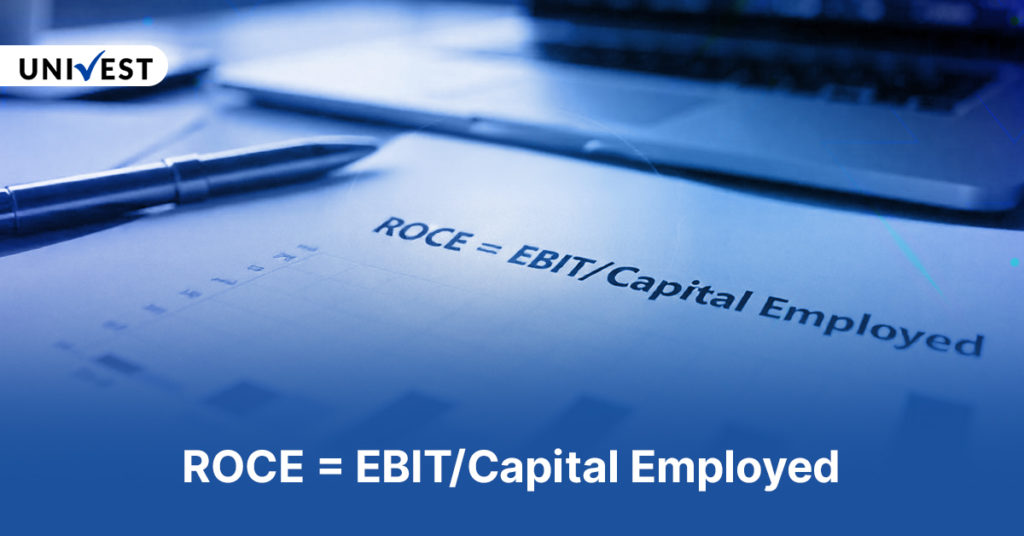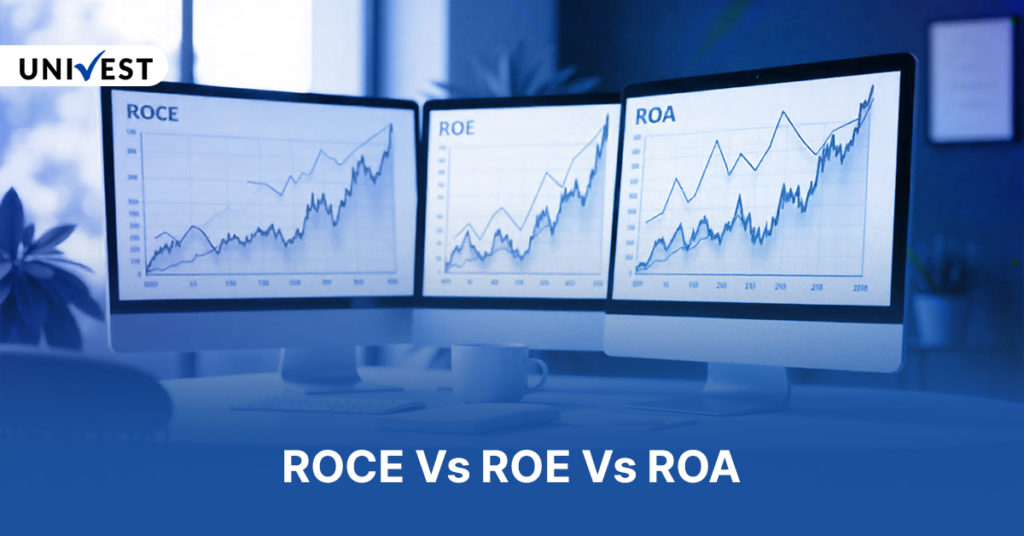
Return on Capital Employed (ROCE): All You Need to Know About
Posted by : sachet | Mon Jun 30 2025

Return on Capital Employed (ROCE) is a way to measure and understand how well a company is using its capital funds to generate profits in business. It helps in showing if the company is good at making more money from the money it has already invested as its capital employed.
Investors of a company, including fund managers, financial institutional investors, or other market participants, use the return on capital employed (ROCE) formula to help them make a decision whether it’s a smart investment that can deliver profit or not. In simpler terms, understanding what is return on capital employed ROCE ratio helps investors answer the questions “Is this company making proper use of the capital funds which it has invested?” and “Can I make profits by investing in a company which is able to generate more money from its initial capital employed?”.
Continue reading further to learn what the Return on Capital Employed (ROCE) ratio is, how to calculate the ROCE formula, its importance, and limitations. Moreover, get to know the factors affecting the ROCE return on capital employed ratio in the stock market.
What is Return on Capital Employed (ROCE)?
Return on Capital Employed (ROCE) is a profitability ratio that helps in measuring the efficiency of a company to generate profits from its capital employed. Basically, it helps investors assess if an organisation is able to make more money from the capital funds it has already invested in the business. Learning how to calculate the ROCE formula is one of the best financial metrics used by many investors and financial analysts to determine the financial performance and capabilities of a company in terms of capital efficiency.
Let Univest help you understand what is return on capital employed ROCE ratio is!
Return on Capital Employed (ROCE) Formula

In order to learn what is return on capital employed (ROCE) ratio and how to calculate ROCE ratio, it is important to know the return on capital employed ROCE formula.
Return on Capital Employed (ROCE) Formula = EBIT/Capital Employed
Where,
EBIT implies the Earnings Before Interest & Tax
Capital Employed = Total Assets – Current Liabilities
Earnings Before Interest & Tax (EBIT) means the company’s profit with all types of expenses except those of interest and tax.
Capital employed is the total amount of money invested in the business.
Download Univest to help you know how to calculate ROCE return on capital employed!
What Does the ROCE Formula Show?
The Return on Capital Employed ROCE formula shows the efficiency of a company in using its total capital, including both equity and debt, to generate profit. A higher ROCE return on capital employed will indicate better capital efficiency and strong fundamentals of the companies. Moreover, many analysts and investors use this return on capital employed ROCE formula to compare different types of companies and identify the ones with capital efficiency in their operations.
Example of Return on Capital Employed (ROCE)
For instance, ABC Ltd. has an operating profit of 5,00,000 in 2024. The company’s total assets amount to 50,00,000 and the current liabilities are 30,00,000. So, the calculation as per the return on capital employed ROCE formula will be as follows:
EBIT = ₹5,00,000
Capital employed = ₹(50,00,000 – 30,00,000) = ₹20,00,000
So, Return on Capital Employed (ROCE) = 5,00,000/20,00,000 = 25%
Therefore, the return on capital employed ROCE of ABC Ltd. is 25%.
For more clarity on what is return on capital employed ROCE, download Univest!
Importance of Return on Capital Employed (ROCE)
Return on Capital Employed (ROCE) formula is a key financial metric used by investors and analysts as it holds a lot of significance while evaluating a company’s performance. The importance of return on capital employed ROCE formula is as follows:
- Measures Capital Efficiency
Understanding what is Return on Capital Employed ROCE formula can help in knowing how effectively a company can use its funds, both debt and equity, to generate more profits. Through this, it helps many investors to evaluate whether the company’s capital funds are being deployed efficiently to grow the business or not. Thus, calculating return on capital employed (ROCE) ratio using the ROCE formula helps them make better investment decisions.
- Operational Performance
Return on Capital Employed (ROCE) ratio uses EBIT, which focuses solely on the business operations of the company. This is because it excludes expenses like interest and taxes, thus providing a better picture of the operational performance of the company and how well the capital employed in the business is managed.
- Investment Comparison
Practicing how to calculate ROCE return on capital employed using the ROCE formula allows investors to compare companies within the same industry, especially in the sectors that are capital-intensive. It helps in identifying which companies are utilising their capital in a more efficient way and delivering better return on capital employed ROCE ratio in the business.
Key Factors Affecting ROCE in the Stock Market

The Return on Capital Employed (ROCE) ratio of a company is affected by a lot of factors. Some of these factors affecting how to calculate ROCE formula are mentioned below:
- Company Earnings
The ROCE formula is directly affected by the EBIT of the company. If a company has reported very strong earnings growth because of higher sales or better profit margins, the Return on Capital Employed (ROCE) formula improves. However, if the profits of the company are falling, the ROCE return on capital employed ratio declines. Many investors closely track earnings because changes in profitability can significantly impact capital efficiency in the stock market.
- Asset Efficiency
Efficient use of assets of the company increases the output without increasing capital employed, which enhances the return on capital employed ROCE ratio. If a company generates more revenue with its existing resources, return on capital employed (ROCE) formula improves. On the contrary, underperforming assets will lower the ROCE.
- Debt Levels
Taking on debt leads to an increased amount of capital employed. If these borrowed funds do not produce a proportional increase in the operating profit, the return on capital employed ROCE formula ratio will decline. Stock markets view excessive debt in a negative way because it reduces capital efficiency and increases risk. So, debt levels also affect the return on capital employed (ROCE) ratio in the ROCE formula.
- Sector Trends
The level of Return on Capital Employed (ROCE) ratio varies across different types of industries. Capital-intensive sectors often have a lower ROCE return on capital employed. Industry cycles, regulatory changes, and market demand also affect the sector’s profitability and asset utilisation. This influences a company’s return on capital employed (ROCE) and investor sentiment in the stock market.
Limitations of Return on Capital Employed (ROCE)
Despite many advantages of the Return on Capital Employed (ROCE) formula , there are some limitations too. Some of these limitations of return on capital employed ROCE formula are mentioned below:
- Inaccurate for Inter-firm Comparison
One of the key drawbacks of return on capital employed (ROCE) formula is that even though it is beneficial when comparing the financial performances of two firms that are in the same sector, it does not offer precise data when comparing organisations that are in different industries.
- Not Sufficient Without Other Metrics
Using the return on capital employed ROCE formula as a single metric of financial performance is not completely sufficient because it only provides information on the capital usage of the company and not other important factors. So, it is always preferable to combine the Return on Capital Employed (ROCE) formula with other financial metrics and ratios in order to make more rational investment decisions.
- Lack of Consistency
The Return on Capital Employed (ROCE) ratio does not remain constant over time and changes from year to year based on the annual market performance of the company. As a result, when we are comparing many different firms, it is critical to evaluate how to calculate ROCE return on capital employed ratio changes over time.
How Companies Can Improve Return on Capital Employed (ROCE)?
The Return on Capital Employed (ROCE) ratio can be improved by increasing the efficiency of the capital invested in the business. Some ways in which the return on capital employed ROCE formula can be improved are as follows:
- Improving Operational Efficiency
Making improvements in the operational efficiency of a company involves streamlining and optimising its operations to reduce costs and improve productivity. This will lead to a potential increase in profitability. This is because these solutions help in eliminating waste of time or resources and enhance efficiency to improve return on capital employed ROCE formula.
- Effective capital allocation
Effective capital allocation to improve the return on capital employed (ROCE) ratio involves evaluating and prioritising capital investment decisions. Companies can focus on projects with high potential returns and align investments with the company’s strategic objectives to make the best out of the given resources. This will help in improving the ROCE formula of the company.
What is a Good Return on Capital Employed (ROCE)?
Even though there is no such particular number for a good return on capital employed (ROCE) as per the industry standards, a higher return on capital employed (ROCE) ratio implies more efficiency of companies’ operations. Generally, we may consider 20% or above as a good return on capital employed (ROCE) ratio to anticipate a constant growth trajectory.
However, a lower value might be indicative of a company which is having a lot of cash on hand, which means that the cash component has been included in total assets. Sometimes, the companies may even perform better with a lower ROCE return on capital employed ratio. So, it is ideal to properly analyse the company fundamentals and ROCE return on capital employed.
ROCE Vs ROE Vs ROA: Which Is Better?

| Criteria | ROCE | ROE | ROA |
| Full Form | Return on Capital Employed (ROCE) | Return on Equity | Return on Assets |
| Formula | EBIT / Capital Employed | Net Income / Shareholders’ Equity | Net Income / Total Assets |
| Uses | ROCE formula helps in measuring the efficiency of total capital employed. | ROE helps in measuring the profitability for equity holders of the company. | ROA measures the efficiency of asset utilisation by the company. |
| Ideal For | Capital-intensive businesses | Equity investors | Asset-heavy businesses |
| Limitation | May ignore the cost of debt. | Doesn’t account for leverage. | Ignores the cost of financing. |
Conclusion
Return on Capital Employed (ROCE) ratio is a common financial metric used by many investors and analysts. It is a measure of the efficiency of a company to generate profits from its invested money, that is, capital employed in the business. The ROCE formula holds a lot of significance while assessing a company’s financial performance. However, one must consider other relevant factors and ratios rather than relying only on the return on capital employed (ROCE) ratio.
For more expert insights on return on capital employed (ROCE), download the Univest app now!
FAQs on Return on Capital Employed (ROCE)
What is Return on Capital Employed (ROCE)?
Ans. Return on Capital Employed (ROCE) is a profitability ratio that helps in measuring the efficiency of a company to generate profits from its capital employed. Basically, it helps investors assess if an organisation is able to make more money from the capital funds it has already invested in the business. Understanding terms like EBIT and capital employed can help you learn what is return on capital employed (ROCE) and how to calculate ROCE.
What is the formula for Return on Capital Employed (ROCE)?
Ans. To learn how to calculate ROCE formula, it can be done by using the formula mentioned below:
Return on Capital Employed (ROCE) = EBIT/Capital Employed
What is the importance of Return on Capital Employed (ROCE)?
Ans. Return on Capital Employed (ROCE) is important for many investors and analysts because ROCE formula helps assess the capital efficiency of a business. It also helps in getting more and better clarity regarding the operational performance of the company being analysed. Moreover, the return on capital employed ROCE formula is a key financial metric for comparing different companies for making investment decisions.
What are the limitations of Return on Capital Employed (ROCE)?
Ans. Despite its crucial significance, return on capital employed (ROCE) has certain limitations. Some of these limitations of return on capital employed ROCE formula are that it lacks consistency, as it changes from time to time. It is not an appropriate financial measure for inter-firm comparisons in different sectors. Even for companies in similar sectors, the return on capital employed ROCE formula is not entirely sufficient to analyse the financial performance of a company and needs to be used with other relevant ratios.
How to improve ROCE formula?
Ans. ROCE Return on capital employed ratio can be improved by streamlining operational processes to improve operational efficiency. Moreover, the return on capital employed ROCE formula can be increased by allocating the capital properly.
Read Our Articles on the Best Stocks
Best Large Cap Stocks in India 2025
Best Cement Stocks To Invest in India
What is Earnings Per Share EPS?
Top Multibagger Penny Stocks For 2025 | Potential Picks
Fundamentally Strong Stocks on NSE in 2025
Debt-Free Penny Stocks in India 2025
Best Realty Stocks In India 2025
Debt Free Penny Stocks Below 1 Rupee
Also Explore
Univest Screeners
Explore Webstories on Univest
1. Best Time To Buy Dividend Stocks
2. How RBI Policies Affect Dividend Stocks
3. Can Dividend Stocks Beat Inflation
4. What Is The Dividend Aristocrat List

